07: Tagging
Between The Lines - Ch 08: Training - by Dr Julian Pepperell
|
Tagging is part of game fishing. But have you ever asked: Why are we tagging? The answer should be, not to score points, but to gain knowledge about the gamefish of the open ocean which would otherwise be difficult, if not impossible, to realise. Tagging provides information on such aspects as movements, stock structure, growth rates, and even indicators of mortality rates for many species. Tagging programs are really major scientific undertakings, and as such, should be carried out as carefully as possible. Because of the sheer logistics of these programs, with tags being distributed to thousands of anglers around the world, it is unrealistic to expect total quality control. However, by following some simple procedures from start to finish, it is possible to considerably improve the quality of data produced by you, the angler. PreparationWe all know how difficult it can be to find the fish, so when the reel screams, everything needs to be just right - from hook-up to release or capture. We all know that all of the fishing tackle and gear should be meticulously prepared... but what about the tagging equipment? Unfortunately, this often seems to be the last set of gear checked, if it's checked at all.To begin with, any serious fishing crew should appoint one member to be responsible for tagging equipment, and also for completing and sending in tag cards. That person should make sure the boat has a good supply of tags well in advance of any fishing activity. They should also make sure tags are stowed somewhere safe, and kept in order. Good quality tag poles should also be positioned for ready access. The next part of the preparation should be to inspect the tags and tagging equipment to ensure everything will run smoothly at the critical moment of tagging. If using steel-headed tags, make sure they are sharpened by giving them a touch up with a sharpening stone or file. Check all tag applicators. For steel tags, the two prongs should be sufficiently long to hold the tag head firmly, but not squeezed together so that the tag will be difficult to release. For nylon-barbed tag applicators, keep them sharp as well to avoid any problems with penetration of thick-skinned fish. It is also an excellent policy to always have two tag poles fully loaded and stowed in a handy position. If one doesn't work, or the tag falls out, the other will be immediately on hand. Tagging ProcedureOnce a fish has been brought to the boat, there is a decision to be made about whether to tag the fish in the water, or in the boat. As a rule of thumb, fish larger than about 20kg should be tagged in the water, in which case, the steel-headed or ‘Billfish Foundation'-style tags, which are designed to anchor in muscle, should be used. (fig 1) Alternatively, if the fish is small enough to be safely handled, it can be lifted from the water for tagging.
When lifting smaller gamefish, hold the trace near the mouth, carefully swing the fish over the side and quickly cradle it under the free arm. Landing nets may also be used, but the mesh and knots can damage the surface of the fish, and often, it is difficult to disentangle the fish prior to tagging. It's always a good idea to be wearing wet cloth gloves when about to handle a fish, and a good tip is to hold the fish upside down, cradling its back in one hand. Most fish will immediately calm down if this is done and be much easier to tag with minimum trauma. Using the nylon-barbed tags (fig 2) in this situation is advisable since they can be placed accurately at the base of the second dorsal fin to anchor firmly behind a fin ray or neural spine. When tagging a small tuna, trevally or similar species in this way, keep the barb of the tag head facing the fish so that it will lock in place properly. After removing the tag pole, twist the tag slightly and give it a little tug to make sure it is locked. To see how this actually happens, note the following tags in yellowfin tuna - one dissected to show how the tag should be anchored (Vid 1) the other a skeletonised section of a fish tagged about nine months previously. Note the bones of the fin rays have been slightly deformed in growing around the tag head, but that the tag is well-and-truly locked in place showing that this tag was there to stay. (Fig 3)
However, if the nylon-barbed tag is simply jabbed into shoulder muscle, it will not have the holding power of the metal tag (Fig 4) or Billfish Foundation tag, and will almost certainly be shed in a matter of months. Tagging a fish in the water requires a certain amount of practice (Vid 2) and skill. Once the fish is on the trace, it should be gently led to one corner of the cockpit, and 'walked' forward so that it is held to one side of the boat. Minimum pressure should be applied to the trace to manoeuvre the fish, since sudden jerks or tugs will often cause the fish to 'jump on the wire', creating an uncontrolled situation. The tagger should be ready for the first opportunity to place the tag, ideally in the shoulder muscle (Fig 5) just below the first dorsal fin. In the heat of the moment, there is a tendency to 'stab' at the fish with the tag pole, but stay calm! The easiest method is to simply place the tag close to the target area and push the tag in place with a short, firm prod. A quick, small twist of the pole, with the tag in place, will tend to ensure that the tag 'grabs' and is released from the applicator.
All tags should be placed at an angle of at least 45° so that they trail with minimum resistance as the fish swims. Remember, most gamefish are capable of very high burst speeds, and if a tag is not angled back, it will vibrate and very likely work its way lose. Releasing fish after tagging is straightforward, but there are some actions which may help in the survival of the fish. Firstly, and obviously, don't keep the fish out of water for any longer than is absolutely necessary. All game fish are high metabolic species, which means they need plenty of oxygen, so try to keep the time out of water down to less than a minute, preferably shorter. Smaller fish can be measured during the tagging procedure - an embedded or attached tape on the floor of the boat, or on the gunwale is ideal for this purpose. Don't throw the fish back, but rather, spear it firmly head first into the water so that it immediately gets a good 'breath' of oxygen-rich water. For fish tagged in the water, try to remove the hook if it is easy to do so, but if not, the trace should be cut as near to the hook as possible. Don't worry too much if the hook can't be readily removed. Hooks around the mouth area will generally wear a hole and fall out quite quickly while non-stainless hooks will corrode over time. It is preferable not to bring a lively billfish onboard for photographs, since it may injure itself in the process, or at the least, lose some of its protective body slime. It's also not a good idea to lift heavy billfish by the bill since this may injure tendons along the vertebral column. However, lifting smaller, docile fish from the water, preferably by cradling them under the middle of the body, is not considered harmful. A billfish brought to the boat 'tail-wrapped' or very tired should be resuscitated. The best way to do this is to unwrap the line from the tail, hold the fish by the bill and if possible, the first ray of the dorsal fin keeping the mouth under the water. Tow the fish very slowly alongside the boat in an upright position until the fish shows signs of movement and possible brighter colour changes. When it kicks its tail and swims away, the extra effort will be worthwhile. Data RecordingAfter the tag is inserted, and all the back-slapping and champagne sipping have subsided, comes the boring bit - filling in the paperwork. Here is another good reason to have a designated tagging mate on Filling in the tag card should be done immediately after release. Often, cards are not completed until the trip home, in which case there is a real risk of getting details wrong. When completing cards, things to note immediately after release are the exact location of release and the estimated (or measured) size of the fish. Don't wait until the end of the day to ask around the boat for 'guesstimates' of sizes of fish tagged. Usually, the impression of size is best immediately after the event. Carefully fill in all other details, including the proper spelling of the boat name, angler's name and address, club and so on, since all of these details are important for accurate computer records and point-scoring. Finally, there is a space on the card labelled 'Remarks'. Here, write in the condition of the fish at release (healthy, bleeding, etc), and if possible, the position of the hook (deep, in corner of mouth), whether the hook was removed, and whether live or dead bait or a lure, was used. These details are extremely important in considerations of survival of tagged fish. Finally, it's also a very good idea to keep a notebook on the boat to record all tag details before tag cards are sent in. Not only is this a handy record of tagging activity to keep on the boat, but it provides another failsafe against the cards being 'lost in the mail'. Data CommunicationAfter all of the above procedures have been followed, there is one last task to complete - the simple matter of mailing the tag card. More often than many would like to admit, fish are tagged, cards are filled in, and then popped into a drawer or tackle box, and promptly forgotten. And if you do find old tag cards, remember it's never too late to mail them. Apart from the need to have as complete records of all tagged fish as possible, it is also vital to match up recapture and release information. Occasionally, a recaptured fish is reported for which no tag card has been received. The release information on these recaptured fish must be out there somewhere, so any unposted cards should be popped in the mailbox as soon as possible. It's always a thrill hearing about a fish which you tagged being recaptured again, but that information will never be forthcoming if the tag card doesn't reach its final destination. Recapture DrillA recapture of a tagged fish is a relatively rare event, so, therefore, every effort should be made to reap maximum information.
Okay, so you have a fish alongside, or onboard, and an earlier tag is noticed protruding from its back. The question often asked is, should the tag be snipped off and the fish re-tagged, or should the fish be kept for scientific examination. Unfortunately, there is no clearcut answer, but generally speaking, if the tag looks very fresh (bright yellow with no growth) then it is probably a very recent tag so the fish can be returned after first either recording the tag number, or better, cutting off the tag and putting another into the fish. If the fish is small enough to measure, then, by all means, do so. Alternatively, if the tag is fairly obviously an old one, usually identified by being faded and covered with at least some growth, then the advice is to keep the fish, if possible, for later scientific examination. It should be wrapped in plastic and frozen, and a call made to the tagging organisation for advice. Very useful information can be gathered from inspection of recaptured fish, including more accurate growth rates, the condition of previously caught fish and effectiveness of different types of tags and tagging sites. One other point on reporting recaptures of tagged fish. In these days of nearly 100% release of billfish, previously tagged fish are quite often caught and re-released without being able to retrieve an earlier tag. If you do hook and release a fish which has a previous tag in place, you should definitely record the details (even though the tag number is unknown) and report the incident to the appropriate tagging organisation as a genuine recapture. In this way, better statistics on actual recapture rates of billfish will be able to be maintained. It goes without saying that tagging is now a completely integral part of game fishing. Let's hope that this brief outline will help to ensure that the vital information being gathered through tagging will be maximised for the benefit of all concerned. Keep on tagging!
|





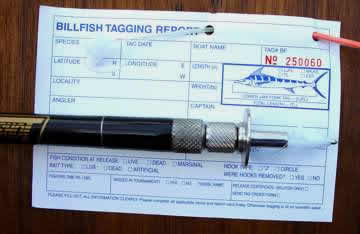
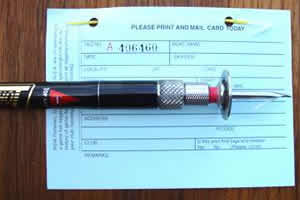
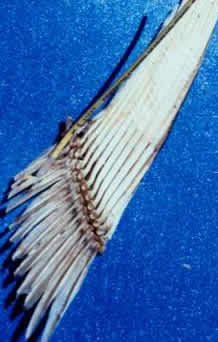
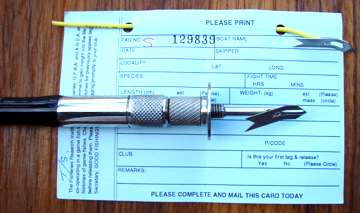
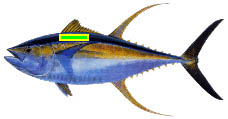
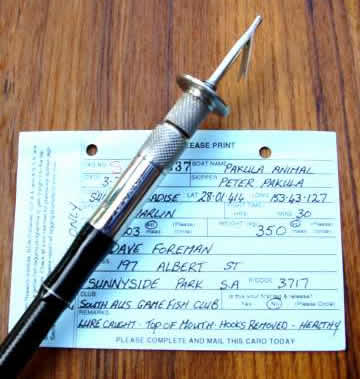 board. At least everyone knows whose job it is to take out the pen and start writing.
board. At least everyone knows whose job it is to take out the pen and start writing.